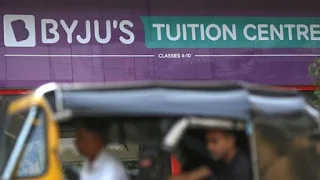Sunday, April 7, 2024
Gold has broken through the $2,300 level, and one market veteran has a bullish call looking ahead
Saturday, April 6, 2024
U.S. and China to hold talks on 'balanced growth' amid overcapacity concerns, Yellen says PUBLISHED SAT, APR 6 2024 3:
U.S. and China to hold talks on 'balanced growth' amid overcapacity concerns, Yellen says
‘Outrage against international law’: Mexico breaks diplomatic ties with Ecuador over embassy raid
‘Outrage against international law’: Mexico breaks diplomatic ties with Ecuador over embassy raid
 |
How to photograph April 8's solar eclipse with a camera or a smartphone
How to photograph April 8's solar eclipse with a camera or a smartphone
Before you start taking pictures, wear eclipse glasses
New calculations have raised concerns popular eclipse maps might be off. Here’s what scientists say
New calculations have raised concerns popular eclipse maps might be off. Here’s what scientists say
Calculations that use a slightly larger radius for the size of the Sun yield an eclipse path that is slightly narrower,” said NASA spokesperson Karen Fox in an emailed statement. “This difference would only affect cities on the very edge of the path of totality, where blanket predictions are difficult regardless — a few city blocks one way or the other could mean 20, 10, or 0 seconds of totality.”
And for viewing purposes, NASA scientists and other experts recommend that spectators head for the middle, rather than the perimeter, of the path anyway.
“I would never, never be near the edge of where that totality is because it’s a difference between night and day,” said Dr. Edward Guinan, a professor of astronomy and astrophysics at Villanova University.
Mapping the moment
Recent questions around a potentially shifting path have focused on a new map calculated by Guildford, England-based software developer John Irwin and published to a webpage called Besselian Elements.
The research hasn’t been thoroughly reviewed by scientists, Guinan said. And even if the NASA map is wrong, Irwin’s calculations indicate it’s only off by a couple thousand feet on the edges.
Irwin did not immediately respond to an email request for comment Friday.
But few things in science are ever certain. And NASA also acknowledges that exact measurements of the eclipse path are difficult to pin down.
“(P)recise eclipse prediction has brought new attention to a tiny but real uncertainty about the size of the Sun,” NASA’s statement reads. “Uncertainty in the Earth’s rotation can also affect eclipse predictions on this level.”
Guinan explained that it’s extremely difficult to determine an exact measurement of the sun’s size because “it’s a fuzzy surface.”
He noted that the sun could be slightly enlarged right now because the our star is currently going through a period of maximum magnetic activity, which “could cause the sun to swell out a bit.”
But the uncertainty accounts for only a few hundred feet, while the moon is millions of miles across.
Still, even slight adjustments in the sun’s size could gently alter the edges of the moon’s shadow on Monday.
Edge effects
The Besselian Elements website advertises that people should consult Irwin’s alternative eclipse map if they’re hoping to travel to the edge of the path — where the length of total darkness may be extremely brief but onlookers could catch a prolonged glimpse of various other eclipse-related phenomenon.
Guinan notes that eclipses do offer “edge effects.”
“You wouldn’t see the total eclipse, but you would see this diamond ring effect — flashes of the sun going in and out behind mountains and coming through valleys on the moon,” he said. “That would be kind of cool to do if you have seen a lot of eclipses.”
Gaza: Israel urged to publish full report on aid worker deaths
Gaza: Israel urged to publish full report on aid worker deaths
 |
| Seven aid workers were killed in three drone strikes on a convoy of vehicles |
 |
Thursday, April 4, 2024
Google AI content under premium now? Search engine says it's 'not considering ad-free experience'
Google AI content under premium now? Search engine says it's 'not considering ad-free experience'
 |
| Google logo and AI Artificial Intelligence words are seen in this illustration |
Byju’s seeks arbitration over NCLT trial in dispute with investors
Byju’s seeks arbitration over NCLT trial in dispute with investors
Exchanges' poor communication and not RBI's circular causing losses in currency-derivatives, say sources
Exchanges' poor communication and not RBI's circular causing losses in currency-derivatives, say sources :
 |
| Traders and brokers told Moneycontrol that they were told to expect a rollback from the regulators. |
Retail traders have been hastily exiting their currency-derivative positions, incurring significant losses, after brokers alerted them to an impending RBI circular just days before its implementation deadline. However, experts said that the requirement outlined in the circular is not new and has been in place since at least 2020.
Trump leads Biden in six swing states amid stiff presidential battle, poll finds
Trump leads Biden in six swing states amid stiff presidential battle, poll finds
In the poll, the negative views for Biden outweighed the positive ones by at least 16 percentage points and more than 20 points in four of the states.
 |
| Donald Trump has an edge over Joe Biden in six of the seven swing states, new poll by WSJ finds(AFP) |
The journal added that the results were similar in a “one-on-one matchup” with the US president on the ballot that included third-party and independent candidates. Meanwhile, in the seventh state, Wisconsin, where Biden was already ahead by 3 points on a multiple-candidate ballot, the two rivals were tied in a “head-to-head contest,” per Reuters.
RBI defers implementing FX derivatives rules to May 3
RBI defers implementing FX derivatives rules to May 3
Taking Stock: Sensex, Nifty close at new highs, all eyes on RBI policy
Taking Stock: Sensex, Nifty close at new highs, all eyes on RBI policy
The Indian benchmark indices climbed to record highs, squandered some of the gains but still managed to close in the green in a volatile session of trade on April 4, a day ahead of Reserve Bank of India (RBI) policy announcement.
Tuesday, April 2, 2024
Netanyahu says aid workers’ killing tragic, ‘happens in wartime’: 10 points
Netanyahu says aid workers’ killing tragic, ‘happens in wartime’: 10 points
The seven workers killed in the strike were citizens from Australia, Britain, Poland, a Palestinians and a dual citizen of the United States and Canada.
 |
| People inspect the site where World Central Kitchen workers were killed in Deir al-Balah, Gaza Strip, |
In Short
🔸Seven killed in Israeli strike at food charity in Gaza
🔸Israeli PM laments killings, but says it 'happens in war'
🔸Countries, including Poland, Spain, the UK, react strongly
Seven people working for the World Central Kitchen aid group in Gaza were killed in an Israeli airstrike on Tuesday. Three of them were British nationals, one Australian, one from Poland, one Palestinian and one dual citizen of the United States and Canada.
Israeli Prime Minister Benjamin Netanyahu lamented the killing of the NGO workers calling the incident "tragic and unintended". However, he also said this "happens in wartime".





